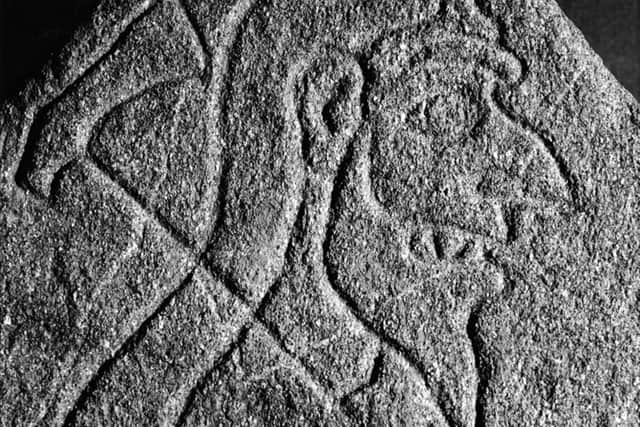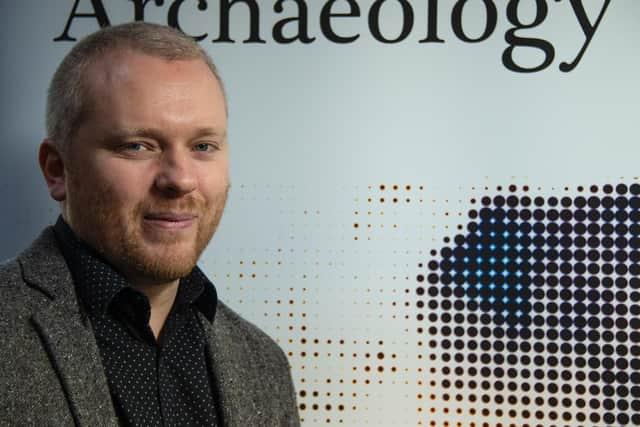Elite spear-carrying Pictish warrior emerges - with bold hair, a necklace and tight leggings


Analysis of the two-metre tall Tulloch Stone stone found by workmen close to MAcdiarmid Park in Perth two years ago has revealed some fascinating new insights into Pictish society and those who probably fought to defend it.
The faint outline of the male figure could be seen on the stone after it was removed from the soil but now - thousands of photographs later - the monolith has been reconstructed in 3D.
Advertisement
Hide AdAdvertisement
Hide AdThis has allowed archaeologists to compare the markings and design to those found on other key Pictish-era stones from Rhynie in Aberdeenshire and Newton of Collesie in Fife to help 'fill the gaps' in Scotland's undocumented history.


Professor Gordon Noble, head of archaeology at Aberdeen University, said: “By looking at the three stones together, we have been able to draw new conclusions about what these figures represent.
“He also has a very distinctive hairstyle, is wearing a helmet and necklace and has a faint line around the left ankle which could suggest footwear or tight leggings.


“In line with the other stones, this is clearly a depiction of a warrior. Its find spot overlooks the coming together of the rivers Tay and Almond, a junction marked by a Roman fort and later a possible Pictish royal centre, suggesting the monolith might have been located in a cemetery of the elite."
He said the Tulloch Stone warrior was likely a generic sacred image, rather than a depiction of someone buried at the cemetery, given similarities with the design found on the other two stones.
This generic image points to a war lord or warrior ethos which has been well documented in Anglo Saxon England but for which little evidence has previously existed in Scotland, according to the research, which is now published in archaeological journal Antiquity.
Professor Noble added “This bridges a crucial gap in knowledge as although we know that warrior ideology is important for rulership, we haven’t previously been able to demonstrate how that evolves through time in the period before the sixth and seventh centuries when we begin to get historical records for Scotland.
“We believe that the weapon-bearing individuals shown on these stones may represent a war-oriented social organisation that was integral to resisting the Roman Empire and to creating the overtly hierarchical societies of the post-Roman period.”
Advertisement
Hide AdAdvertisement
Hide AdThe stone is likely to have been made in the 5th to 6th Centuries and depict the type of warrior who arose in the late Roman period.
The Romans left the Antonine Wall, the empire's most northerly frontier that stretched across the Central Belt of Scotland, around 162AD and left Britain completely at the turn of the the 5th Century.
The Tulloch Stone was discovered during construction work for the A9/A85 scheme, part of the Perth Transport Futures Project, and is now undergoing further research and conservation prior to going on display in a new museum being developed for Perth, set to open in 2022.
Dr Mark Hall, archaeological curator at Perth Museum, who has also worked on the research, said increased public awareness of Scotland’s Pictish past was opening up new opportunities for important archaeological study.
He added: “Most of the recent Pictish finds have been as a result of people paying greater attention.
“The workmen who scooped up this stone did well to realise that there was something on it and to alert the appropriate authorities.
“It is likely that there are more Pictish stones out there to be found and every new stone is a fantastic addition to the corpus.
“This discovery of the Tulloch stone has revealed fresh details allowing the reconsideration of the existing related sculptures, fostering new insights and conclusions that are not possible when only dealing with a single example.”
Advertisement
Hide AdAdvertisement
Hide AdThe full paper detailing their research findings has been made available free of charge.
Kevin Grant, Archaeology Manager at Historic Environment Scotland, said: “We are delighted to be able to fund Open Access for this paper, allowing everyone to freely access information about this exciting discovery.”
